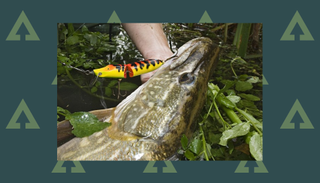How to catch pike with lures - everything you need to know
If you want to learn how to catch pike with lures, follow Alan Dudhill's top tips ideal for your summer and early autumn sessions

Welcome to Advnture, the new home of AnglersMail.co.uk
When it comes to catching pike with lures, a mobile approach is my favourite for warmer water pike, before cooler autumn weather and then winter kicks in.
You may be lucky enough to identify a swim and cast a lure straight to a waiting fish but more often than not, piking can be a waiting game with many hours or even days waiting for a pike to come on the feed.
Lure fishing is so successful because you’re not waiting for the fish to feed. You’re finding the fish.
Being more mobile in your approach will greatly improve your chances of catching and will massively increase your catch rate.
Cover all areas of your chosen swim in a methodical manner. Sometimes you have to virtually run the lure past the pike’s nose before it’s tempted to strike.
- How to catch pike at night
- How to unhook pike: unhooking fish safely
- The best pike deadbait rods
If fishing a narrow drain or canal, always cast your lure ahead of where you’re walking so you don’t spook the fish. Remember, pike are often laying in wait in shallow water and margins.
Advnture Newsletter
All the latest inspiration, tips and guides to help you plan your next Advnture!
Lure fishing is a very versatile method and allows you to cover lots of water and different features. If you start to catch, stay in the swim for a while, re-casting over the same area.
Pike are often found in groups so it pays to hang around a bit once you find where they are.
A pike may only feed at certain times, which will vary from water to water and may go long periods without feeding. Large pike do not have to feed very often and spend most of their time laid-up in wait for a passing meal.
Lure fishing is the perfect method for locating these holding areas. Offer the pike an easy meal and it will rarely be able to resist it.
Read on for more top tips on how to catch pike with lures.
How to catch pike with lures - big lures
Many of the country’s top lure anglers opt for using very big lures. These may seem a little excessive but there’s method in the madness…
Firstly, the theory of ‘big baits = big fish’ comes into play. Large pike prefer larger prey; they’re an easier and longer lasting meal and less energy is used up catching large prey as opposed to chasing around after small fry. This is how the pike has grown so big in the first place.
Another theory of why large lures are so successful is because the pike see the large fish (lure) as an intruder and will attack it whether hungry or not. This is certainly the case with other pike, which is why pike imitation lures work so well. Big pike will not tolerate the intrusion of a smaller one.
Whatever the reason, big lures are far more successful for big pike. Small pike are also perfectly capable of eating surprisingly large prey. Often, small jacks are caught on lures not much smaller than them selves.
Larger lures come equipped with larger hooks and this makes perfect sense, however, some are excessively big. I prefer to scale-down the hooks to a size 1/0 or 2/0. These are usually more than big enough to hook the fish and far less likely to cause damage by double-hooking the pike with a trailing treble.
How to catch pike with lures - exciting surface lures
The warmer months see pike actively striking at prey fish on or just below the surface. When in a feeding frenzy they will have a go at virtually any artificial lure.
Using surface lures is one of the most exciting methods for catching warm weather pike. They will hit the lures with full-on aggression, causing a huge swirl or even breaking clear of the water.
Surface lures are a great way of covering large areas of heavily weeded water, drawing the pike up from within the vegetation to hit the lure as it passes above the weed.
There are all manner of surface lures available from the floating plugs to disturbance lures such as the ‘splutter bug’, which splashes somewhat awkwardly across the surface. Some of these lures do not appear to resemble anything at all but annoy or arouse the pike to induce a take.
Of course pike will have frogs and toads on their menu at this time of year so replica frogs work very well. Rodents are also on the menu so if you’re lucky enough to come across a ‘Heddon Mouse’ or ‘Rat’ lure, these will give surprising results, particularly on narrow drains where pike rarely miss an opportunist snack.
One of my favourite surface lures is the ‘Crazy Crawler’, which looks like a giant bumble bee with fins. This doesn’t appear to resemble any creature on the planet and it’s water-disturbing action makes it one of the strangest looking of lures but certainly one of the most successful.
‘Poppers’ are one of the most popular surface lures. These are basically a plug but instead of a diving vain, they have a concave front, which resists the water as it’s retrieved, causing disturbance and an erratic movement.
Pike find it difficult to resist surface lures when the water is warm and they’re at their most active. Perhaps because they are so visible and obvious but I suspect their strange actions trigger some predator instinct to ‘attack’.
Whatever the reason, they work and make for very exciting sport!
Most Popular

